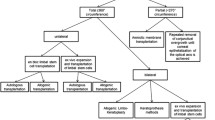Summary
Background: Nonmechanical trephination has been established as the standard procedure in penetrating keratoplasty (PK) for avascular corneal diseases at our institution. The purpose of this study was to analyze the incidence and reversibility of immunologic graft reactions after nonmechanical trephination and to detect potentially causative factors.
Patients and methods: Out of a total series of 400 nonmechanical PKs, 286 consecutive procedures with sufficient follow-up performed between 07/1989 and 09/1997 were included in the study (104 × keratoconus, 78 × Fuchs' dystrophies, 31 ×bullous keratopathies, 28 × ulcers, 25 × avascular scars, 12 × stromal dystrophies, 4 × buphthalmos, 4 × others; 202 × PK only, 84 × combined procedures; 276 first PK). The age of the 138 females and 148 males at the time of surgery ranged from 16 to 89 (mean 55 ± 19) years. The recipient and donor trephinations were performed from the epithelial side using an 193-mm excimer laser (MEL50 or MEL60, Aesculap-Meditec, 1.5 ×1.5 mm spot mode, 16–24 mJ/pulse, repetition rate 30 or 25/s; metal masks). The shape of the recipient trephination was either circular with four or eight “orientation teeth” (n = 251; 5.0–8.0 mm diameter) or elliptical (n = 35, 6.0 × 7.0 to 7.5 × 8.5 mm diameter). In 62 % of procedures fresh or short-term-preserved donor tissue was used, and in 38 % of procedures the donor tissue was organ-culture-preserved.
Results: During a mean follow-up of 22 ± 18 months (maximum 7.7 years), 10 acute diffuse (3 irreversible; 1.0 %) and 3 chronic focal endothelial graft reactions occurred (4.5 %) not earlier than 4 months and not later than 35 months after PK. Elective procedures (3.5 %) resulted in significantly (P = 0.01) less reactions than acute corneal ulcers (14.3 %). After 1, 2 and 3 years, the cumulative reaction rates (Kaplan-Meier values) were 1.3 %, 6.3 % and 13.9 % in elective procedures, none of which, however, occurred after 26 elliptical trephinations. With fresh or short-term-preserved donor tissue (4.2 %), graft reactions did not happen more frequently but earlier (12 ± 6 months) than with organ-culture-preserved donor tissue (2.2 %, 30 ± 6 months). In patients with keratoconus (4.9 %), reactions occurred more frequently (P = 0.05, LogRank) and earlier than in patients with Fuchs' dystrophy (1.3 %).
Conclusions: In addition to well-established optical advantages, nonmechanical trephination seems to have no immunologic drawbacks.
Zusammenfassung
Hintergrund: Die nichtmechanische Hornhauttrepanation ist heute in unserer Klinik das Standardverfahren bei der perforierenden Keratoplastik (PK) zur Therapie avaskulärer Hornhautprozesse und wurde bisher bei 400 Augen erfolgreich durchgeführt. Ziel der Studie war die Analyse der Häufigkeit und Reversibilität immunologischer Transplantatreaktionen nach nichtmechanischer Trepanation sowie deren Einflußgrößen.
Patienten und Methoden: Im Zeitraum von 07/1989 bis 09/1997 gingen 286 konsekutive Operationen mit ausreichender Beobachtungsdauer in die Studie ein (104 × Keratokonus, 78 × Fuchssche Dystrophien, 31 × bullöse Keratopathien, 28 × akute Ulzera, 25 × avaskuläre Narben, 12 stromale Dystrophien, 4 × Buphthalmus, 4 × sonstige; 202 × alleinige PK, 84 × kombinierte Eingriffe; 276 Erst-PK). Das Operationsalter der 138 Frauen und 148 Männer schwankte zwischen 16 und 89 (im Mittel 55 ± 19) Jahren. Die Empfänger- und Spendertrepanation wurde mittels eines 193 nm-Excimerlasers (MEL50 bzw. MEL60, Aesculap-Meditec, 1,5 × 1,5 mm Punktprofil, 16–24 mJ/Puls, Repetitionsrate 30 bzw. 25/s; Metallmasken) von epithelial durchgeführt. Die Empfängertrepanation war entweder rund mit 4 bzw. 8 „Orientierungszähnchen bzw. -kerben“ (n = 251; 5,0 bis 8,0 mm Durchmesser) oder elliptisch (n = 35, 6,0 × 7,0 bis 7,5 × 8,5 mm Durchmesser). Bei 62 % der Operationen wurde frisches bzw. kurzzeitkonserviertes, bei 38 % organkultiviertes Spendergewebe verwendet.
Ergebnisse: Insgesamt ereigneten sich während einer mittleren Beobachtungsdauer von 22 ± 18 Monaten (maximal 7,7 Jahren) 10 akute diffuse (davon 3 (1,0 %) irreversibel) und 3 chronische fokale endotheliale Transplantatreaktionen (4,5 %) frühestens 4 Monate und spätestens 35 Monate nach PK. Bei Elektiveingriffen war die Gesamtrate (3,5 %) signifikant (p = 0,01) geringer als bei Ulzera (14,3 %). Nach 1, 2 bzw. 3 Jahren war bei 1,3 %, 6,3 % bzw. 13,9 % der Elektiveingriffe eine Transplantatreaktion aufgetreten (Kaplan-Meier-Werte), jedoch nach keiner der 26 elliptischen Trepanationen. Bei kurzzeitkonserviertem Spendergewebe (4,2 %) traten die Reaktionen nicht signifikant häufiger, jedoch früher (12 ± 6 Monate) als bei organkultiviertem Gewebe (2,2 %, 30 ± 6 Monate) auf. Bei Keratokonus (4,9 %) ereigneten sich die Reaktionen häufiger (p = 0,05, LogRank) und früher als bei Fuchsscher Dystrophie (1,3 %).
Schlußfolgerungen: Im historischen Vergleich scheint die nichtmechanische Trepanation neben optischen Vorteilen immunologisch zumindest keine Nachteile zu haben.
Similar content being viewed by others
Author information
Authors and Affiliations
Rights and permissions
About this article
Cite this article
Seitz, B., Langenbucher, A., Kus, M. et al. Immunologic graft reactions after nonmechanical corneal trephination using the excimer laser. Ophthalmologe 95, 607–618 (1998). https://doi.org/10.1007/s003470050323
Published:
Issue Date:
DOI: https://doi.org/10.1007/s003470050323




